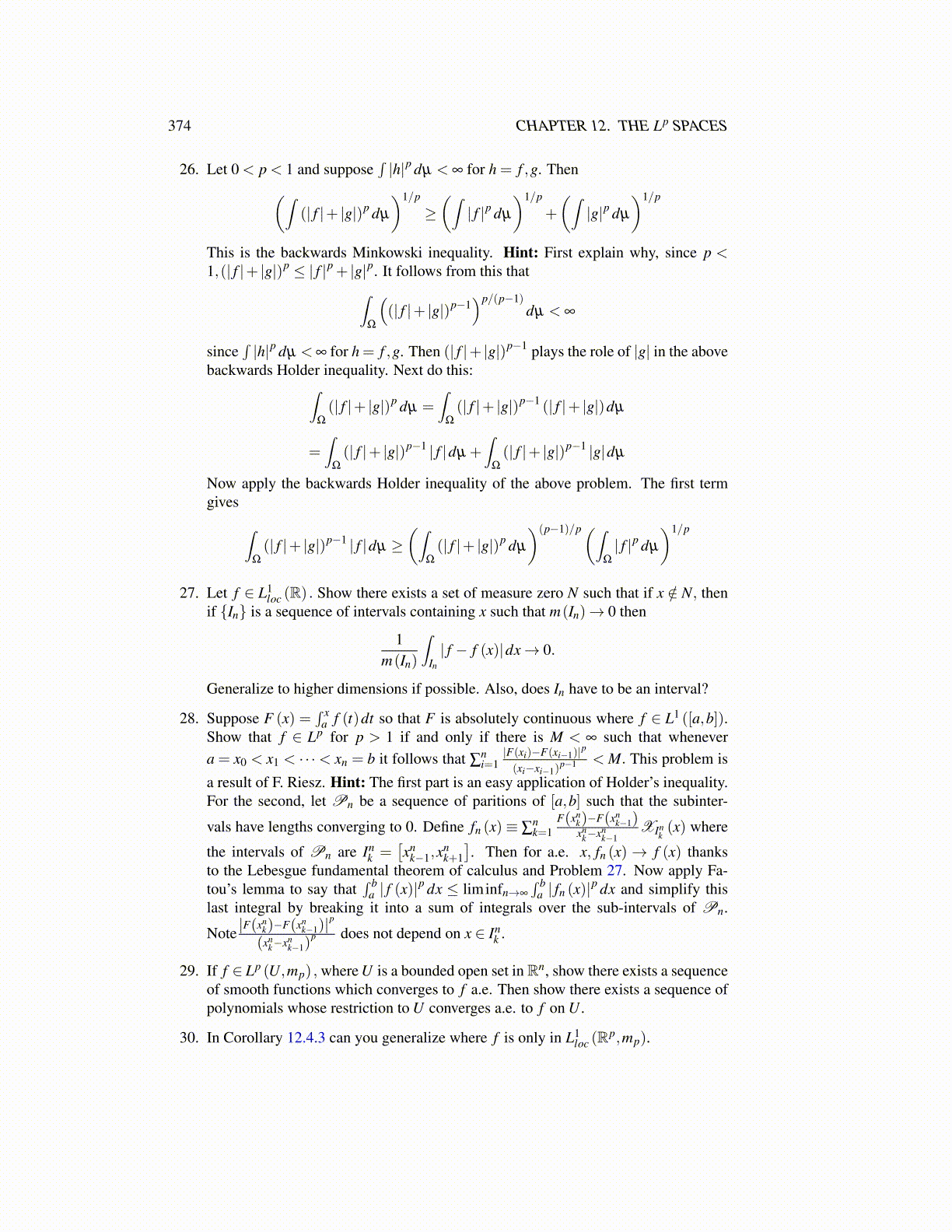
374 CHAPTER 12. THE Lp SPACES
26. Let 0 < p < 1 and suppose∫|h|p dµ < ∞ for h = f ,g. Then(∫
(| f |+ |g|)p dµ
)1/p
≥(∫| f |p dµ
)1/p
+
(∫|g|p dµ
)1/p
This is the backwards Minkowski inequality. Hint: First explain why, since p <1,(| f |+ |g|)p ≤ | f |p + |g|p. It follows from this that∫
Ω
((| f |+ |g|)p−1
)p/(p−1)dµ < ∞
since∫|h|p dµ < ∞ for h = f ,g. Then (| f |+ |g|)p−1 plays the role of |g| in the above
backwards Holder inequality. Next do this:∫Ω
(| f |+ |g|)p dµ =∫
Ω
(| f |+ |g|)p−1 (| f |+ |g|)dµ
=∫
Ω
(| f |+ |g|)p−1 | f |dµ +∫
Ω
(| f |+ |g|)p−1 |g|dµ
Now apply the backwards Holder inequality of the above problem. The first termgives ∫
Ω
(| f |+ |g|)p−1 | f |dµ ≥(∫
Ω
(| f |+ |g|)p dµ
)(p−1)/p(∫Ω
| f |p dµ
)1/p
27. Let f ∈ L1loc (R) . Show there exists a set of measure zero N such that if x /∈ N, then
if {In} is a sequence of intervals containing x such that m(In)→ 0 then
1m(In)
∫In| f − f (x)|dx→ 0.
Generalize to higher dimensions if possible. Also, does In have to be an interval?
28. Suppose F (x) =∫ x
a f (t)dt so that F is absolutely continuous where f ∈ L1 ([a,b]).Show that f ∈ Lp for p > 1 if and only if there is M < ∞ such that whenevera = x0 < x1 < · · ·< xn = b it follows that ∑
ni=1|F(xi)−F(xi−1)|p
(xi−xi−1)p−1 < M. This problem is
a result of F. Riesz. Hint: The first part is an easy application of Holder’s inequality.For the second, let Pn be a sequence of paritions of [a,b] such that the subinter-
vals have lengths converging to 0. Define fn (x)≡ ∑nk=1
F(xnk)−F(xn
k−1)xn
k−xnk−1
XInk(x) where
the intervals of Pn are Ink =
[xn
k−1,xnk+1
]. Then for a.e. x, fn (x)→ f (x) thanks
to the Lebesgue fundamental theorem of calculus and Problem 27. Now apply Fa-tou’s lemma to say that
∫ ba | f (x)|
p dx ≤ liminfn→∞
∫ ba | fn (x)|p dx and simplify this
last integral by breaking it into a sum of integrals over the sub-intervals of Pn.
Note |F(xnk)−F(xn
k−1)|p
(xnk−xn
k−1)p does not depend on x ∈ In
k .
29. If f ∈ Lp (U,mp) , where U is a bounded open set in Rn, show there exists a sequenceof smooth functions which converges to f a.e. Then show there exists a sequence ofpolynomials whose restriction to U converges a.e. to f on U .
30. In Corollary 12.4.3 can you generalize where f is only in L1loc (Rp,mp).